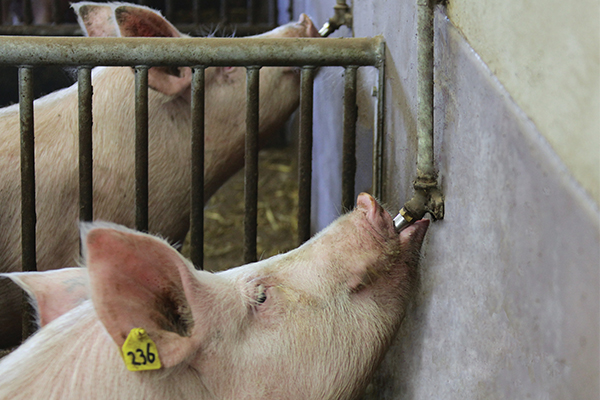Water is the single nutrient that is required in the greatest quantity by swine and should be closely monitored. Pigs require water for most metabolic functions, to control body temperature, to transport food and waste products throughout the body, for the production of milk and for growth and reproduction. Water usage is also a very good predictor of health issues. Pigs consume the majority of water by drinking, but some water is ingested through the feed or is generated through metabolism. Pigs excrete water via the urine, feces, respiration and evaporation (skin).
Factors affecting water requirements
Because there is no simple answer as to how much water pigs need it is important to first note the different factors that influence the amount of water required;
-
Temperature of both the environment and the water
-
Relative humidity
-
Health of the pig
-
Dietary Factors: Amount of Feed consumed; Protein content; Salt content; Fibre content; Water content
-
Salinity and other water quality components

Water requirements and supply
The table below shows guidelines for water requirements for pigs in different stages of production but as mentioned above requirements can change depending on different factors. Recommended flow rates and guidelines for the height of the drinkers are also listed. As a general rule nipples should be mounted 5 centimeters above shoulder height for the smallest pig.
|
Class of Pig
|
Litres/day
|
Gallons/day
|
Water Flow Rate Nipples (litres/min)
|
Height Nipple Drinkers (mm)
|
|
Newly Weaned
|
1.0-1.5
|
0.2-0.4
|
0.5
|
100-130
|
|
Nursery Pig (<20kg)
|
1.5-2.0
|
0.4-0.5
|
0.7-1.0
|
130-300
|
|
Grower Pig (20-40kg)
|
2.0-5.0
|
0.5-1.3
|
1.0-1.5
|
300-460
|
|
Finisher Pig (40-100kg)
|
5.0-10
|
1.3-2.5
|
1.2-1.5
|
460-610
|
|
Sows and Gilts (Open and Pregnant)
|
9.0-18
|
2.3-4.5
|
2.0
|
610-760
|
|
Lactating Sows
|
20.-40
|
5.0-10
|
2.0
|
610-760
|
|
Boars
|
5.0-12
|
1.3-3.0
|
2.0
|
760-910
|
Besides having the right water flow rates and height of the water supply it is important to have enough drinkers available per pig. The table below shows the drinker to pig ratios for different types of drinkers.
|
Type
|
Restricted feeding
|
Ad Lib Feeding
|
|
Nipple
|
1:10
|
1:15
|
|
Bite Drinker
|
1:10
|
1:15
|
|
Bowl
|
1:20
|
1:30
|
|
Double sided trough
(per 300 mm)
|
|
< 15kg
35 pigs per trough
|
15-35kg
30 pigs per trough
|
35kg
25 pigs per trough
|
|
The maximum pressure for weaner drinkers is 85-105 kPa or 12-15 psi. The maximum pressure for grower finisher drinkers is 140-175 kPa or 20-25 psi. To avoid feed waste, the distance between the feeder and the drinker should be no more than 2 meters.
Proper functioning of the water supply should be examined on a daily basis.
· Make sure all drinkers work and there are no leaks
· All drinkers should be clean
· Can the drinker be accessed properly and is it at the right height and angle?
· Is there a sufficient flow of water and is the pressure correct?
The quality of the water should be examined twice a year. Check for pathogenic and non-pathogenic bacteria, mineral content and other physical characteristics.

Water and performance
Water availability can have a big impact on performance. A restriction of the water supply has been shown to negatively impact feed intake, average daily gain and feed conversion in Nursery, Grower and Finisher pigs.
For lactating sows, a reduction in water intake will decrease feed intake and subsequently milk production and weaning weights. Sows will also lose more condition during lactation which has a negative impact on the next litter size. Not enough water will aggravate constipation and insufficient water supply in gestation can cause urinary tract infections.
Nutritionpartners